From Ruins to Revival: The Story of Middelburg’s Only Jewish Synagogue
Sruly Meyer
I had just returned from a week-long business trip when I got a call from cookbook author and food blogger Naomi Nachman. “Hey Sruly, how would you like to go to Amsterdam?” she asked me in a tone that made it hard to tell if she was serious or not.

I told her I’d love to, even though Amsterdam was not exactly on my bucket list of travel destinations. Naomi invited me on behalf of Kosher River Cruises to join them on their trip to the Netherlands and work with them to document the experience.
Just a week after that phone call, I was pulling my suitcase up the ramp to board. This was my first time joining a cruise, let alone a kosher one sailing out of Amsterdam. I wasn’t sure what to expect from an all-Jewish cruise that mixes Jewish history with local city sites.
I’m happy to report that it was an incredible experience. The sights were, of course, stunning, and the surrounding areas of Holland and Belgium have rich histories and glorious views. However, it was the Jewish history of these towns that left its real mark on me.
Amsterdam’s Rich Jewish History
We started off in Amsterdam, a very famous city that had several Jewish spots to visit. For some historical context, let me set the stage for you.
Before the Second World War, Amsterdam was home to a vibrant Jewish community. The city was often referred to as the “Jerusalem of the West” due to its significant Jewish population. Notable neighborhoods, like the Jewish Quarter, were bustling hubs of Jewish culture, trade, and religious life. The famous Jewish scholar Rabbi Moshe Chaim Luzzatto, known as the RamChal, author of the well-known Mesilas Yesharim, moved from Italy to Amsterdam. The flood of Jews that came here following the Spanish Inquisition helped build the famous Portuguese Synagogue.
The Jewish community in Amsterdam, once a thriving home to Jews, faced extreme persecution during WWII. While there were efforts from the Dutch resistance to protect the Jews, the scale of the Nazi operation meant that many were eventually deported and murdered. Starting in 1942, mass deportations of Jews from Amsterdam to concentration and extermination camps began. Jews were initially sent to transit camps like Westerbork in the Netherlands, and from there, to camps like Auschwitz and Sobibor. By the end of the war, of the approximately 80,000 Jews who lived in Amsterdam before the war, only a few thousand survived.
One of the most well-known Jewish victims from Amsterdam was Anne Frank. Her diary detailing her life in hiding has become one of the world’s most famous testimonies of the Holocaust.
During our trip, we visited a recent addition to the city, an emotional and horrifying testament to the Holocaust filled with bricks and name plates of victims, topped with mirror sculptures that when read from above spell out ZACHOR. I even found several rows of people with my own last name, Meyer, but we’ll get to that later.
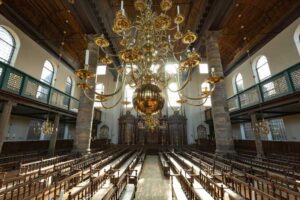
Of course, we visited the famous Portuguese synagogue, and learned all of its well documented history. Including the basement which stores one of the oldest recorded Jewish libraries in the world.
The Middleburg Synagogue
Due to the Halachic ruling that a ship carrying mostly Jewish passengers must dock and be still for Shabbos, we docked in a small town in Holland called Middleburg. Everything about this town lived up to its name. It was a town that felt like the middle of nowhere, a very simple, seemingly boring town. Yet, there was a reason they chose this town, as we would soon come to find out.
Middelburg was home to just about 250 Jews during World War Two. The Jews had a synagogue discreetly situated in an alley. An emblem marked “Beit Knesset” and the date, 1704, were marked on the wall, as a testament to its long-standing heritage.
This synagogue Does it have a name? was one of the first to be built outside of Amsterdam in the Netherlands. There was even an illustration of it that dates back to the early 1700’s chronicled in a magazine at the time.
A plaque in Dutch further chronicles its tumultuous past: “Built in 1704, occupied by the Nazis in 1940, who used it to house weapons. The synagogue was struck by a British mortar in 1944 during the liberation and was almost completely destroyed.”
The synagogue has been through a lot. The Jews of the town were all deported to Amsterdam and eventually sent to death camps. For decades, this sacred place was a mere shadow of its past. Trees sprouted within its ruins. The churches and even two mosques were rebuilt in Middleburg right after the war; however, with no Jews remaining, there was no one to rebuild the synagogue. The heartrending visuals of the neglected, once-proud house of prayer seemed to signify the end of Jewish life in Middelburg.
However, the embers of faith still smoldered.
A Miraculous Rebirth
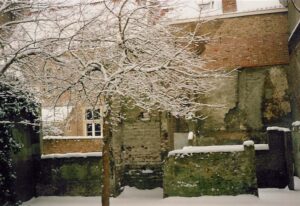
Against all odds, a miracle unfurled. Jews began returning to Middelburg, repopulating and rejuvenating a community once thought extinct. How did this happen? Let me tell you about a very special man.
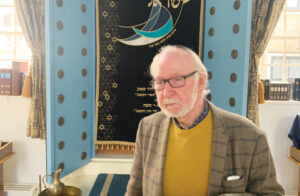
Dr. Aad Vos of Viera was a local non-Jewish doctor who would pass the synagogue site daily on his way to work. His relentless spirit and unwavering determination rallied the community and began a drive to rebuild and restore the synagogue. He felt that the synagogue was an important historic edifice, deserving of its own prominent place in the city. He reached out to the city council, as well as the local churches, and they joined in his efforts. The synagogue was finally rededicated in 1994, almost exactly 50 years after it was destroyed during the war’s end. Sadly though, it was missing only one thing: a Jewish community.
During Shabbos we were honored to meet a Jewish man named Luuc Smit. He lived his entire life in Middleburg. His poignant tale further magnified the miraculous rebirth of Jewish life here. Raised as a Christian, unaware of his Jewish lineage, he learned that his mother had survived the Holocaust by concealing her identity. When she emerged at the war’s end, she married and, fearing that such a catastrophe could happen again to the Jews, decided that she would raise her children as Christians. In fact, Smith’s brother is a Lutheran minister.
Smit’s mother begged her son to hide his lineage, but he was of a different mind. When he was told that he was a Jew, he began to reclaim his heritage, baby steps at a time. He lit candles on Friday night. He found books on Judaism and taught himself to read Hebrew. He learned blessings and said Hamotzi on challah every Shabbos. He eventually prevailed upon a rabbi from a nearby city to teach him Torah.
The revival of the synagogue ignited Luuc’s Jewish soul, leading him on a transformative spiritual journey. His story stands as a testament to the eternal flame of Jewish identity, even in the shadows of history. When Dr. Vos was informed about a local Jewish man who was recently returning to his roots, he reached out to welcome him back to the rebuilt synagogue. Luuc Smit studied to become a cantor and now leads the synagogue in prayers. We were privileged to hear him lead Maariv on Friday night and Shabbos on the ship.
Middleburg Today
Today, the synagogue isn’t just a building; it’s a vibrant hub of Jewish life, celebrations, and traditions. From Shabbos to Yom Tov, the echoes of prayers and melodies fill its walls, just as it had centuries ago.
In 2004, the synagogue was the site of the first Jewish wedding to take place in Middelburg since the war. They recently celebrated the completion of a brand-new sefer Torah. Today, the Jews of Middelburg form a closely knit community of 40 members. In addition to the community organization itself, the Stichting Joods Maatschappelijk Werk (Jewish Social Work Foundation) and the Federatie Joodse Bejaardenzorg (Federation for Care to the Jewish Aged) are also active in Middelburg.
Middelburg is home to two Jewish cemeteries, one Ashkenazi and the other Sephardic. The Ashkenazi cemetery, dating back to 1705, is still in active use. The Sephardic cemetery, which was in use from 1655 to 1721, has recently undergone restoration. Notably, Reb Shmuel, the son of Rabbi Menasseh Ben Israel, is interred in the Sephardic cemetery. Reb Shmuel played a role in petitioning Oliver Cromwell in 1655 to allow the re-entry of Jews into England, contributing to Cromwell’s decision in their favor. Both of Middelburg’s Jewish cemeteries have received national monument recognition.
I left Middelburg with a heart brimming with emotion, gratitude, and awe for the indomitable Jewish spirit. The rebirth of Yiddishkeit in Middelburg, against all odds, is a testament to our unyielding faith and resilience.
My Connection
The cruise ended on a Monday, but my flight was not until Tuesday morning, so I went touring Amsterdam by foot. I found myself in front of the Anne Frank Museum, knowing that getting tickets to enter required advance purchase.
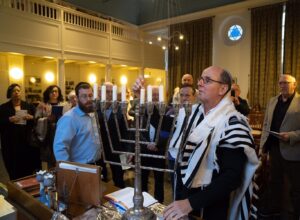
Anne Frank was a cousin of mine; my great grandmother, or Omi as we called her, was second cousins with Otto Frank. My great-grandparents were actually at Anne’s parents’ wedding.
I wanted to just stand there and see the museum for myself, as a distant cousin, honoring the memory of those who died. While standing there I saw an information agent there directing tourists, and I asked her where the famous “front door” of the house was so I could take a photo. I explained to her that I was a cousin and knew that no tickets were available, but I just wanted to take a photo. When she saw my yarmulke and heard that I was a relative, she asked me many questions, and I even showed her the family photo showing my great grandparents at the wedding of the Franks.
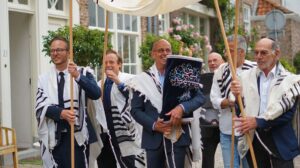
The woman began to tear up and spoke in Dutch to someone on the other end of her earpiece, then told me, “You are family, you are our guests. Follow me, I will take you in.” With that, I was granted access and had the incredible experience of seeing firsthand the horrendous conditions the Franks lived in, hiding from the Nazis.
I was standing there, an Orthodox Jew, with a beard, wearing a yarmulke and tzitzis, in a spot where I’d have been deported 80 years ago. The creaks in the floor reminded me how difficult it must have been to hide for so long, and as the information agent told me, “You are a blessing, you are proof that evil cannot destroy light, and we are honored to have you here.”
We are still here, and we endure. All of the evil empires that hunted us down before are gone, but we are still here. You can take our synagogues, but we will rebuild them. You can break our spirit, but we will reignite it.
I can’t help but think now of the war in Israel. Once again, Jews are facing horrible circumstances, but if history has taught us anything, Hashem will be there to protect us, and we will endure. I find comfort in knowing that Hashem sent me on this trip to be reminded of this, even from a place of personal connection, of our strength to endure.
I recorded this story and uploaded it to my social media channel, and the video went viral. It currently has 650k views with thousands of comments and messages from non-Jews pledging their love and support. It might seem dark at times but let this story, and the ones that come before and after it, be a reminder that we are not going anywhere. May Hashem protect us and watch over us.
You must be logged in to post a comment.